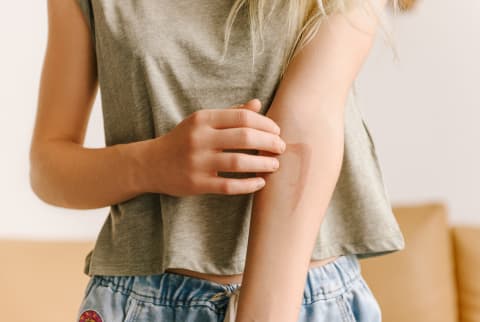Advertisement
Are You Making These Critical Skin Healing Mistakes?


I don't know about you, but tending to a wound is next-level skin care that I've never been well versed in. Luckily, board-certified dermatologist Lindsey Zubritsky, M.D., FAAD, is here to set the record straight.
From inflamed bug bites to scars to cuts and scrapes, here's how to care for your damaged skin—plus the sneaky habits that will thwart all your progress.
What not to do
"I'm a dermatologist, and everything we learned as kids about how to care for a cut or wound is totally wrong," Zubritsky declares over Instagram.
The common care method she refers to is applying hydrogen peroxide and then layering on an antibacterial ointment—while this isn't the method everyone learned, it's certainly a common practice.
Why is this method ineffective? Well, Zubritsky notes that hydrogen peroxide can actually inhibit wound healing1, and some antibacterial lubricants can lead to allergic dermatitis. When used together, the chance of quick and easy healing actually declines.
How to care for a cut or minor wound
If this healing habit does work for you, then great—you are always the expert in your own skin. However, if you're at a loss and want to encourage quicker healing, try the following steps instead:
- Clean it: "As soon as you get a cut or a wound, you're supposed to clean it with antibacterial soap or just gentle soap and water," Zubritsky says. Meaning: no fragranced cleansers you may use for your hands or body.
- Hydrate: Zubritsky recommends covering your wound with an occlusive agent, namely petroleum jelly. While this is certainly a safe option, you can also find plant-based, fragrance-free ointments designed for sensitive skin or wounds if you prefer to go that route for sustainability reasons. Here, find our favorite picks.
- Cover: Finally, Zubritsky says to cover the wound with a bandage.
"Wounds actually heal better when they're moist and covered—this promotes wound healing2," she adds.
It's the same reason experts often recommend using barrier repair creams after procedures like microneedling or laser treatments—when your skin stays hydrated, it's ready to heal.
She notes that this routine will work for almost every type of minor cut or wound. So the next time you get a paper cut or scrape your knee, keep this simple process in mind. Remember: You want to clean and nourish the damaged skin, not irritate it.
The takeaway
Tending to a minor cut or scrape can go south rather quickly. As recommended by Zubritsky, simply clean the wound with antibacterial or gentle soap, then cover it with a fragrance-free healing ointment followed by a bandage. This way, your skin will be primed for effective healing. While you're taking notes on wound healing, you might want to spend some time reading about the best protocol for painful sunburns—here's what you need to know.
